E3AS-HF Series
TOF Laser Sensor with Built-in Amplifier
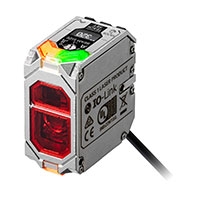
With a wide detection range (0.05 to 6 meters) and excellent angular characteristics (±85° max.), it can detect low-reflective workpieces, such as black ones, even when installed at a distance from the workpiece.
last update: June 2, 2025
1. A wide sensing range and excellent angle characteristics supported at the same time
Performance of conventional long-distance reflective photoelectric sensors is not always stable since their detection performance varies with the colors and shapes of detected objects. With its unique sensing algorithm, E3AS-HF has overcome the problem, eliminating the time and effort to select and set up sensors.
A sensing range of 0.05 to 6 m and angle characteristics of ±85° max.
Place the sensors away from the pathways of people and robots so that the sensors do not obstruct their movement.
Thus remove failure risks such as optical axis displacement and cable disconnection due to collision with a workpiece, and ensure stable sensing when the target workpiece is changed or added.
Sensing whether a painted vehicle body is positioned in place
The sensors perform reliable detection even when installed at an angle in a far place or when detecting glossy workpieces with a low-reflective color like black or blue.
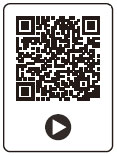
Detecting glossy black workpieces at a wide angle
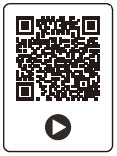
Angle characteristics of 85° max.

Identifying the vehicle model from the body panel
By detecting the holes and pins of the body panel set on the jig, the sensors identify the vehicle model and detect the presence of necessary parts.
The sensors with excellent angle characteristics can be installed away from the pathways of people and robots.
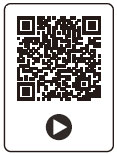
Detecting a small bore with the spot beam type
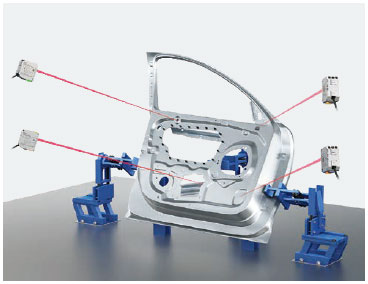
Sensing workpieces in a palletizing process
Multi-color, low-reflective workpieces can be detected reliably. The setup can reduce installation and wiring work compared with through-beam sensors.

Detecting multicolor, low-reflective workpieces
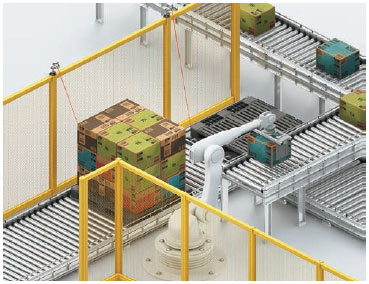
Three technologies underlying the excellent sensing performance
TOF method to stably detect various workpieces
The TOF (Time of Flight) method measures the distance based on the elapsed time. Therefore, measurement is not easily affected by changes in the color and material of the workpieces. The method needs only a low incident light level to perform sensing, so the sensor can detect low-reflective workpieces such as black rubber from a distance.
Operating principle of TOF
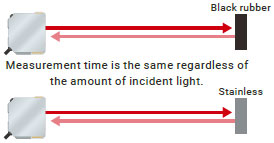
Ultra-fast sampling and unique accumulation processing [PATENTED]*2
By accumulating approximately 10 million data points obtained by ultra-fast sampling at 10 billion times per second, the method obtains a clear incident light waveform and minimizes the noise, enabling stable sensing with a low light level.
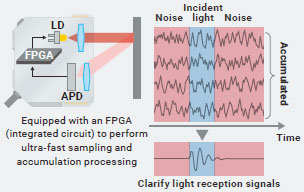
Laser class 1 for safety
Combining as strong an emission as possible within the class 1 limit with the advanced device and high-frequency circuit design technology, the sensor can perform laser control within an extremely narrow pulse width.
This reduces the need for operator safety measures and equipment protection measures, allowing a compact, low-cost equipment design.
High-frequency circuit technology [PATENT PENDING]*2

High-sensitivity photo diode controlling algorithm
The sensor has a high-sensitivity APD*3 that can detect even a slight amount of incident light.
With the built-in temperature element that corrects the temperature in real-time, the sensor reduces characteristics variation and ensures stable sensing.
Real-time temperature correction [PATENT PENDING]*2

*2. “PATENT PENDING” means that we applied for a patent in Japan, and “PATENTED” means that we obtained a patent in Japan. (As of September 2024)
*3. APD: Avalanche Photo Diode
2. Equipment free from mutual interference when multiple sensors are used
Automatic Mutual Interference Prevention
The technology adopted by E3AS-HF can prevent interference between the sensors without the need for their channel settings. It prevents the sensors placed to face each other from causing mutual interference, reducing equipment disruptions.
Sensing pallets in an automated warehouse
It is difficult to predict when the sensors on shuttles will encounter each other while many shuttles are running sideways in an automated warehouse. In such a warehouse, unexpected mutual interference inevitably occurs causing the lines to stop. E3AS-HF, however, has an Automatic Mutual Interference Prevention function that can prevent malfunction without the need for channel settings.

Automatic Mutual Interference Prevention
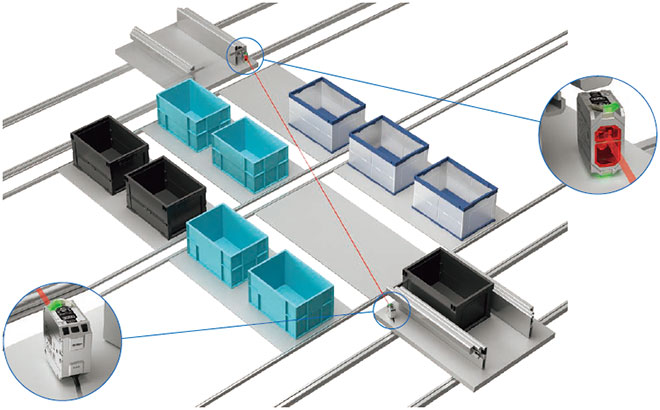
A technology underlying Automatic Mutual Interference Prevention [PATENT PENDING]*1
Sensors have different emission patterns to prevent mutual interference.
If a malfunction still occurs, you can manually modify their patterns.
Image of emission patterns

3. An easily visible OLED display
Setup of conventional reflective photoelectric sensors is complicated and requires skills and experience.
However, the enhanced operability of the sensor allows anyone to reliably perform the setup, reducing commissioning hours and ensuring long-term stable operation.
OLED Display with 5 languages supported
A detection display can be selected according to the usage, so you can quickly see the necessary sensor’s status. In addition, the sensor supports five languages for local operators to smoothly set up the units outside Japan.
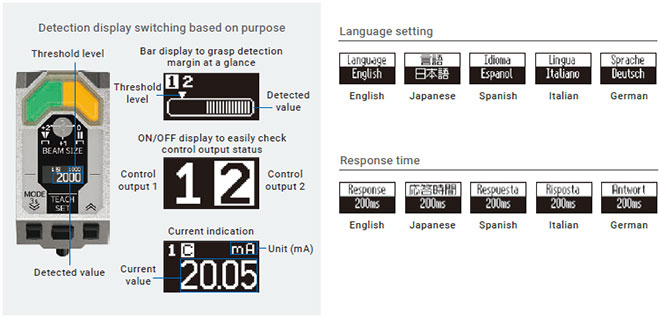
High-brightness indicator at the bottom [PATENT PENDING]*1
The sensor has an indicator at the bottom to help check the operation status of the sensor installed in a high place.
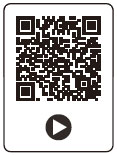
Enhanced visibility with an indicator at the bottom
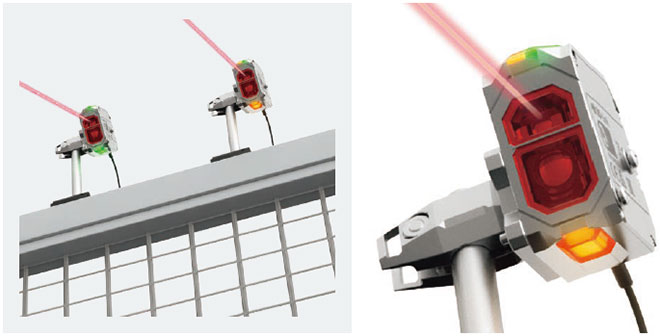
*1. “PATENT PENDING” means that we applied for a patent in Japan, and “PATENTED” means that we obtained a patent in Japan. (As of September 2024)
Various functions for easy use
Adjustable spot diameter [PATENT PENDING]*1
The spot diameter adjustable with the dial on the top of the sensor can be selected from three options according to whether you want to detect a spot on a small workpiece such as a pin or an area on a surface such as a hole.
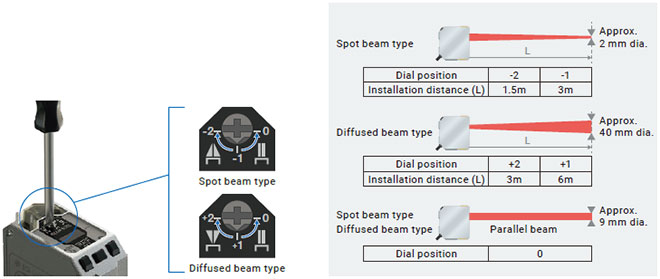
Detecting workpieces on a roller conveyor
The spot diameter can be reduced to approximately 2 mm. Set up the optical axes so that they pass between the rollers to stably detect workpieces only.
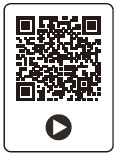
Detecting workpieces with the spot beam type

Detecting how many pallets are remaining
The spot diameter can be increased to approximately 40 mm, allowing stable detection regardless of the shape and holes of the pallets.

Sensing pallets with the diffused beam type
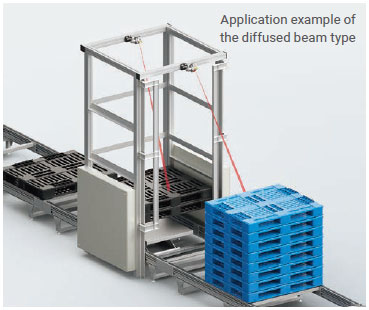
Scaling function
Converts a digital output value (distance) to a given output current value. Use the function when you use a narrow sensing distance range. The scaling function helps you find even small changes.
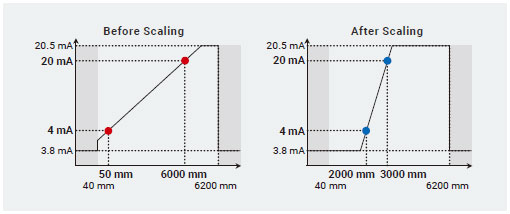
Antifouling coating [PATENTED]*1
A dirty sensing surface can cause false detection due to the principle of photoelectric sensors. The antifouling coating on the sensing surface prevents paper dust, etc. from sticking to the sensing surface, and keeps the lens from fogging as well. Adding an air blow unit available as an accessory can help further reduce the frequency of cleaning the sensor.
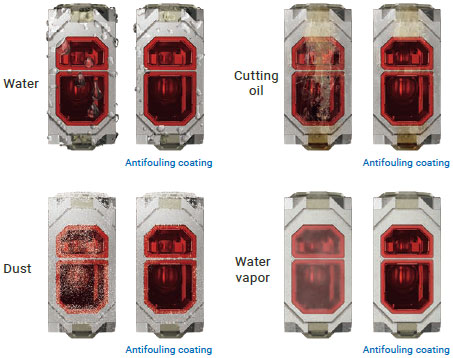
Air blow unit [PATENTED]*1
Attaching an air blow unit helps greatly reduce the frequency of false detection since it prevents contamination of the sensing surface of the sensor installed in a high, difficult-to-clean place.

Environmentally-resistant structural design
Highly resistant to water, oil, and high-pressure washing and can be used in a harsh environment.
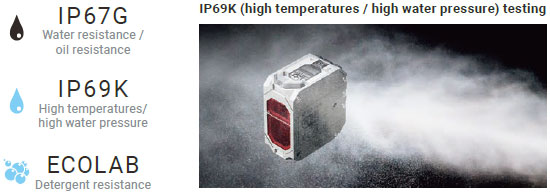
Operable at an ambient operating temperature of -30ºC
With a combination of a heater and a temperature sensor built in to control operation, the sensor can reliably operate in a low-temperature environment such as a freezer warehouse.
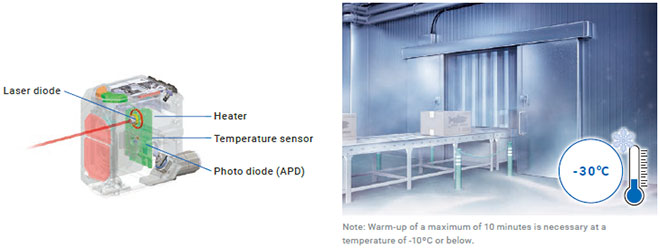
*1. “PATENT PENDING” means that we applied for a patent in Japan, and “PATENTED” means that we obtained a patent in Japan. (As of September 2024)
IO-Link supported as standard to visualize a manufacturing environment
In addition to ON/OFF signals, IO-Link can send and receive the sensor information to and from an upper-level controller. This allows real-time status monitoring of the sensors, reduction of the configuration hours during setup and replacement, and reduction of unexpected equipment disruptions due to accidental problems.
Open international standard
IO-Link is an open information technology (interface) used between a sensor/actuator and an I/O terminal, as defined in IEC61131-9, an international standard.
Globally deployable
Every IO-Link sensor has an IODD (IO Data Description) file containing information about what kind of equipment it is and what parameter settings it needs. The specification of IODD file is globally common and shareable by all IO-Link sensors regardless of their manufacturers.
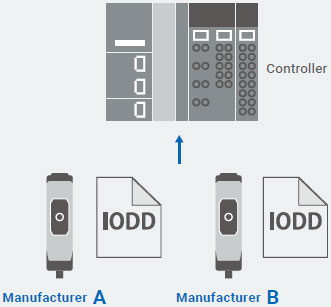
Line commissioning and maintenance with less people in less time with IO-Link
With IO-Link, reduce commissioning time by batch-setting the sensors and cut troubleshooting time during mass production by utilizing field data.

Reduce commissioning time by batch-writing settings from IO-Link device configuration tool
Setting information can be batch-written to thousands of sensors on a line, effectively reducing commissioning time and inconsistent settings.
Predictive monitoring and quick recovery by checking and monitoring sensor data
The monitor shows light intensity decrease due to sensing surface contamination or other reason, allowing users to take proactive actions to prevent potential false detections. This reduces the frequency of unexpected failures.
Converting the equipment information into meaningful data with IO-Link
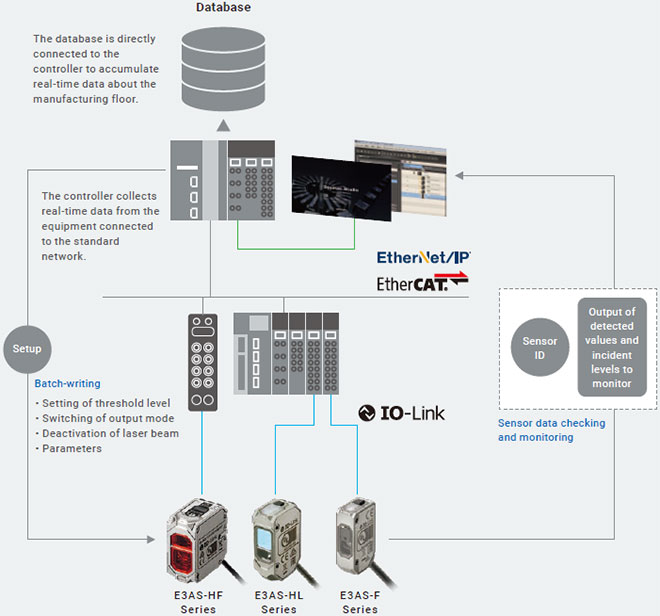
• EtherCAT® is a registered trademark and patented technology, licensed by Beckhoff Automation GmbH, Germany.
• EtherNet/IP™ is a trademark of ODVA.
• QR code is the registered trademark of DENSO WAVE.
• Ecolab and its logo are registered trademarks of Ecolab USA Inc.
• Smartclick is a trademark or registered trademark of OMRON Corporation in Japan and other countries.
• Other company names and product names in this document are the trademarks or registered trademarks of their respective companies.
• The product photographs and figures that are used in this catalog may vary somewhat from the actual products.
last update: June 2, 2025

